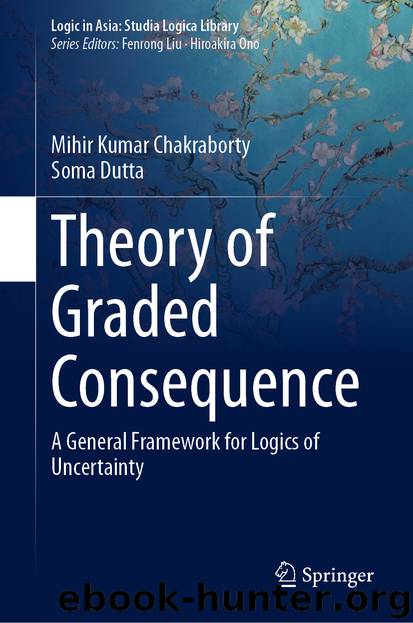Theory of Graded Consequence by Mihir Kumar Chakraborty & Soma Dutta

Author:Mihir Kumar Chakraborty & Soma Dutta
Language: eng
Format: epub
ISBN: 9789811388965
Publisher: Springer Singapore
This kind of construction may be extended to other structures. We fix different algebraic structures for different levels of logic and study the interrelations between the operators corresponding to the object- and meta-level algebraic structures. This process leads towards generating various logics based on GCT. At the end of Sect. 4.3.1, Table 4.3, obtained as an outcome of such investigation, shall be presented.
4.3.1 Many-Valued Logics as a Special Case of GCT
Let us concentrate on the many-valued logics which are generated from BL (Hájek 1998), the logic where the intersection of all tautologies generated from all t-norms constitutes the set of axioms. In Hájek (1998), Peter Hájek has shown that the well-known many-valued logics like Łukasiwicz logic, Product logic (also known as Goguen logic), Gödel logic, etc. can be found as an extension of BL. The set of formulae of these logics is usually mapped to the unit interval [0, 1] or to a subset of [0, 1]. Various t-norms defined over [0, 1] actually correspond to the strong conjunctions of many-valued logics (Hájek et al. 1996). In many-valued logics, usually we see two kinds of conjunctions; one is known as weak/additive conjunction and is computed by lattice meet and the other is known as strong/multiplicative conjunction and is computed by the t-norm. In many-valued context, generally, the classical laws generated from bi-valence do not get satisfied by weak conjunction. Whereas, t-norms corresponding to the strong conjunctions satisfy almost all properties of classical conjunction. So these t-norm-based many-valued logics become the centre of interest. Below we first present a brief overview of these many-valued logics as given in Hájek (1998).
Let be any continuous t-norm, i.e. a function from to [0, 1] such that is associative, commutative and non-decreasing on both the arguments, and 1 is the identity with respect to . Three such well-known t-norms are as follows: (Łukasiewicz t-norm
)] .
Download
This site does not store any files on its server. We only index and link to content provided by other sites. Please contact the content providers to delete copyright contents if any and email us, we'll remove relevant links or contents immediately.
| Algebra | Calculus |
| Combinatorics | Discrete Mathematics |
| Finite Mathematics | Fractals |
| Functional Analysis | Group Theory |
| Logic | Number Theory |
| Set Theory |
Modelling of Convective Heat and Mass Transfer in Rotating Flows by Igor V. Shevchuk(6391)
Weapons of Math Destruction by Cathy O'Neil(6147)
Factfulness: Ten Reasons We're Wrong About the World – and Why Things Are Better Than You Think by Hans Rosling(4694)
Descartes' Error by Antonio Damasio(3230)
A Mind For Numbers: How to Excel at Math and Science (Even If You Flunked Algebra) by Barbara Oakley(3221)
Factfulness_Ten Reasons We're Wrong About the World_and Why Things Are Better Than You Think by Hans Rosling(3199)
TCP IP by Todd Lammle(3134)
Fooled by Randomness: The Hidden Role of Chance in Life and in the Markets by Nassim Nicholas Taleb(3046)
Applied Predictive Modeling by Max Kuhn & Kjell Johnson(3019)
The Tyranny of Metrics by Jerry Z. Muller(3003)
The Book of Numbers by Peter Bentley(2912)
The Great Unknown by Marcus du Sautoy(2648)
Once Upon an Algorithm by Martin Erwig(2599)
Easy Algebra Step-by-Step by Sandra Luna McCune(2585)
Lady Luck by Kristen Ashley(2534)
Practical Guide To Principal Component Methods in R (Multivariate Analysis Book 2) by Alboukadel Kassambara(2497)
Police Exams Prep 2018-2019 by Kaplan Test Prep(2487)
All Things Reconsidered by Bill Thompson III(2357)
Linear Time-Invariant Systems, Behaviors and Modules by Ulrich Oberst & Martin Scheicher & Ingrid Scheicher(2334)
